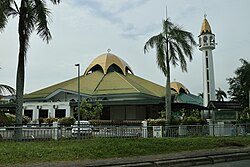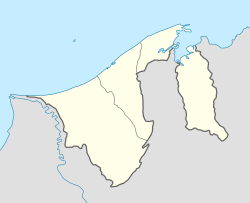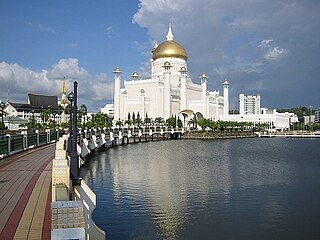
The Brunei–Muara District or simply Brunei–Muara is one of the four districts of Brunei. It has the smallest area among the four districts, with 571 square kilometres (220 sq mi), yet is the most populous, with 289,630 people as of 2016. Bandar Seri Begawan, the country's capital, is located in this district, which is also de facto the district's capital. It is also home to Brunei International Airport, the country's only international airport, as well as Muara Port, the main and only deep-water port in the country. The Brunei River flows within this district and is home to Kampong Ayer, the traditional historic settlement on stilts above the river.

Mukim Kilanas is a mukim in Brunei-Muara District, Brunei. The population was 22,492 in 2016.

Mukim Pengkalan Batu is a mukim in Brunei-Muara District, Brunei. The population was 14,492 in 2016.

Mukim Sengkurong is a mukim in Brunei-Muara District, Brunei. The population was 31,493 in 2016.

Mukim Amo is a mukim in Temburong District, Brunei. It has an area of 542 square kilometres (209 sq mi); the population was 1,657 in 2021.

Mukim Bangar is a mukim in Temburong District, Brunei. It has a total area of 113 square kilometres (44 sq mi); the population was 2,112 in 2021. The mukim encompasses Bangar, the district's sole town and administrative centre.

Kampong Jerudong or simply Jerudong is a village in Brunei-Muara District, Brunei, about 21 kilometres (13 mi) from the capital Bandar Seri Begawan. The population was 3,856 in 2016. It is one of the settlements within Mukim Sengkurong.

Kampong Keriam is a village in Tutong District, Brunei, about 6 kilometres (3.7 mi) from the district town Pekan Tutong. The population was 2,195 in 2016. It is one of the villages within Mukim Keriam, a mukim in the district.

RPN Lambak Kanan, Kampong Perpindahan Lambak Kanan or simply Lambak Kanan is a public housing estate in Brunei-Muara District, Brunei, on the outskirts of the country's capital Bandar Seri Begawan. The total population was 19,833 in 2016. Established in 1986, it is the first estate for the National Housing Scheme, the public housing programme for the country's citizens.
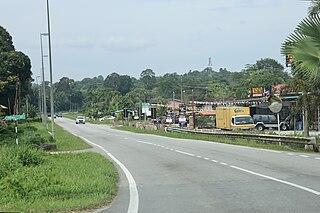
Kampong Luagan Dudok is a village in the north-east of Tutong District, Brunei. The population was 879 in 2016. It is one of the villages within Mukim Keriam, mukim in the district.
Kampong Kulapis is a village in the west of Brunei-Muara District, Brunei, about 13 miles (21 km) from the capital Bandar Seri Begawan. It has an area of 486.71 hectares ; the population was 1,766 in 2016. It is one of the villages within Mukim Sengkurong.The postcode is BG2521.

Kampong Tungku is a village in Brunei-Muara District, Brunei, about 10 kilometres (6.2 mi) from the capital Bandar Seri Begawan. The population was 1,689 in 2016. It is one of the villages within Mukim Gadong 'A'. The postcode is BE2119.
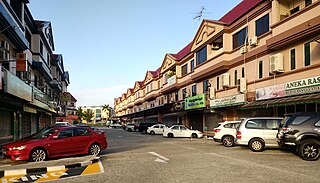
Kampong Kiulap or commonly known as Kiulap, is a village in Brunei-Muara District, Brunei, as well as a neighbourhood and commercial area in the capital Bandar Seri Begawan. It has an area of 176.53 hectares ; the population was 3,400 in 2016. It is one of the villages within Mukim Gadong 'B'. The postcode is BE1518.

Kampong Kupang or simply known as Kupang, is a village in Tutong District, Brunei, about 21 kilometres (13 mi) from the district town Pekan Tutong. The population was 1,795 in 2016. It is one of the villages within Mukim Keriam, a mukim subdivision in the district.

Kampong Bukit Panggal is a village in Tutong District, Brunei, about 10 kilometres (6.2 mi) from the district town Pekan Tutong. The population was 801 in 2016. It is one of the villages within Mukim Keriam, a mukim in the district.

Kampong Bengkurong is a village in Brunei-Muara District, Brunei, on the outskirts of the capital Bandar Seri Begawan. The population was 3,583 in 2016. It is one of the villages within Mukim Kilanas. The postcode is BF1920.

Kampong Lugu is a village in the west of Brunei–Muara District. It comprises the original village settlement and the public housing estate RPN Kampong Lugu. The population was 2,082 in 2016. It is one of the villages within Mukim Sengkurong.
Kampong Batong is a village in the south-west of Brunei-Muara District, Brunei, about 20.5 kilometres (12.7 mi) from the capital Bandar Seri Begawan. It has an area of 978.07 hectares ; the population was 1,225 in 2016. It is one of the villages within Mukim Pengkalan Batu. The postcode is BH2923.

Kampong Peninjau, also known as Kampong Jerudong 'B', is a village in Brunei-Muara District, Brunei. The population was 3,418 in 2016. It is one of the villages within Mukim Sengkurong. The postcode is BG3522.
Kampong Selayun is a village in Brunei-Muara District, Brunei. The population was 1,875 in 2016. It is one of the villages within Mukim Sengkurong. The village is under the responsibility of the village head of Kampong Sengkurong 'B'. It has the postcode BG1721.
